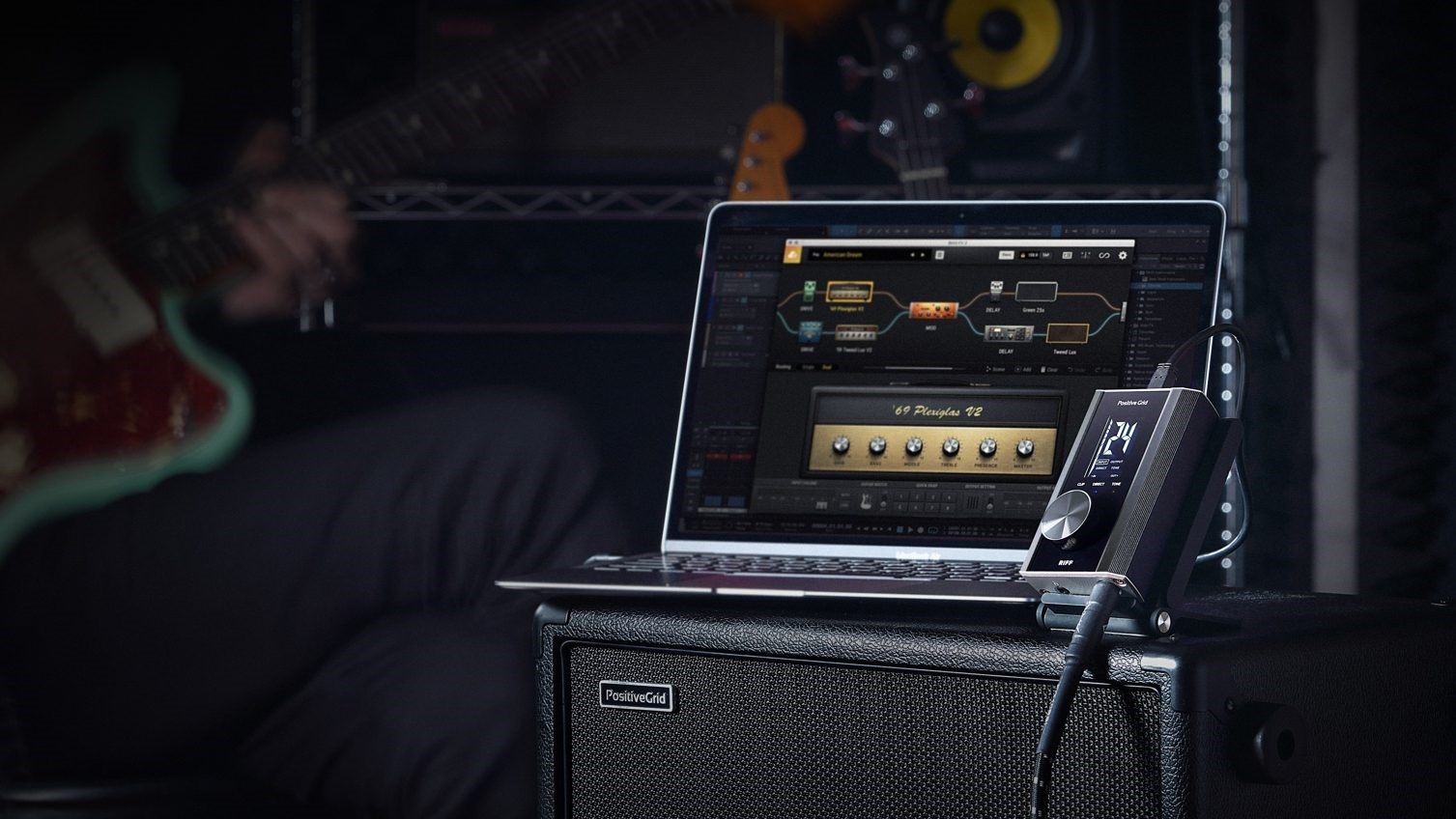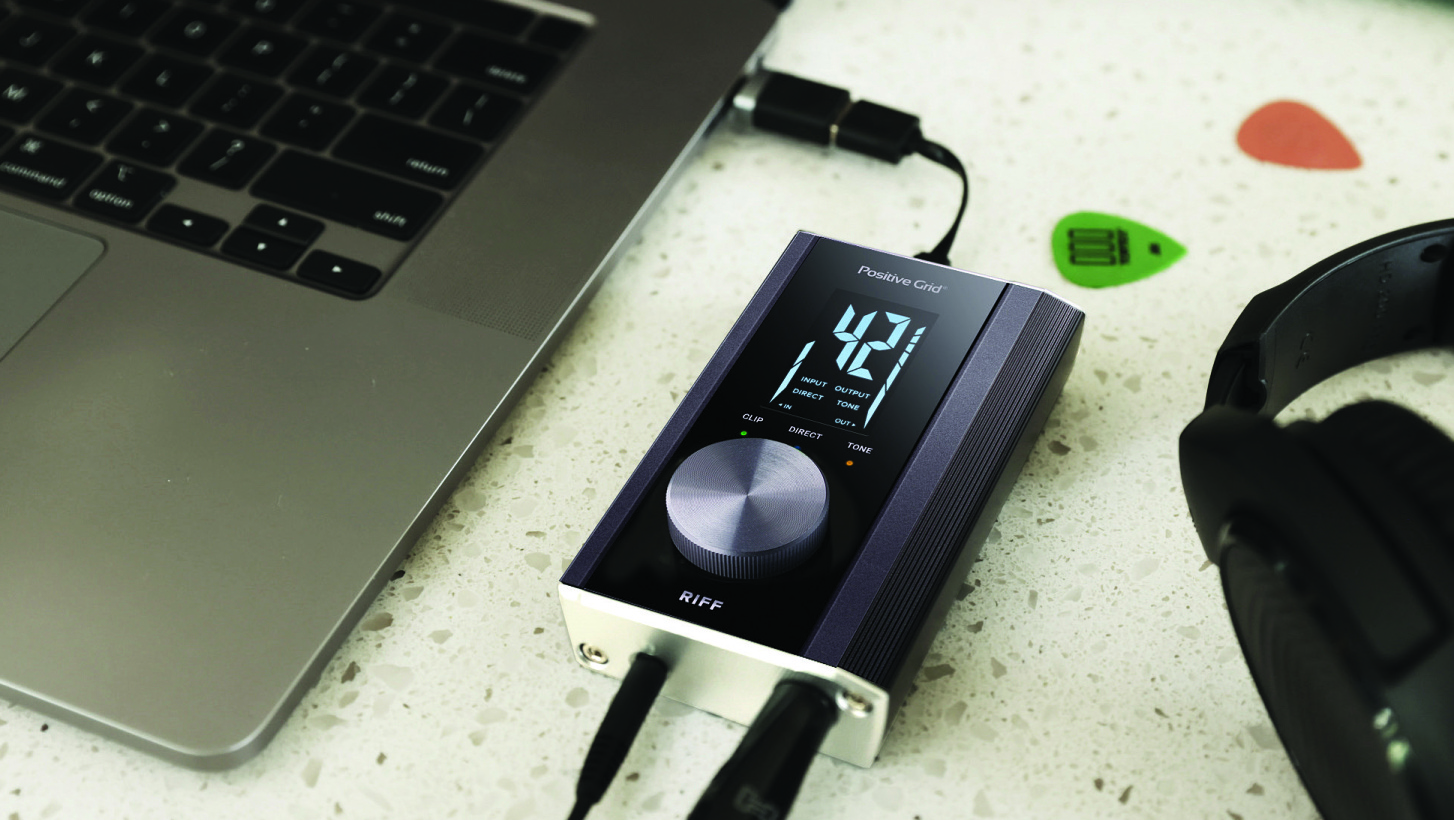GuitarPlayer Verdict
This must-have interface provides fast and intuitive access to great guitar tones, and is a powerful tool for practicing, songwriting, learning, and recording.
Pros
- +
Pristine 24-bit/96kHz audio device optimized for guitar and bass, with three onboard preamp and overdrive emulations. Interfaces with BIAS FX 2 and includes cables for PC and iOS devices
Cons
- -
Too basic to serve as your main audio interface
You can trust Guitar Player.
Positive Grid earned a ton of well-deserved attention in 2020 with Spark, its groundbreaking guitar practice amp and app. The compact, 40-watt combo not only delivers a range of great amp emulations and effects powered by Positive Grid’s BIAS Tone engine but also helps players practice, jam, and learn with a variety of applications and features.
PRICE: $99 direct
INTERFACE: Central control knob (rotate, push), display, and indicators for clip, direct, and tone
I/O: 1/4” mono instrument input, 1/8” stereo headphone output, 1/4” stereo line output, micro USB
DIMENSIONS: 0.85” x 2.16” x 3.47”
COMPATIBILITY: Windows 8 or later/macOS 10.11 or later/iOS 11 or later
Buy from Positive Grid
Now the company brings its trailblazing innovations to RIFF, a compact and portable USB guitar audio interface for computers and mobile devices that’s optimized for electric, acoustic, and bass guitars.
To that end, RIFF features high-resolution audio (24-bit/96kHz) and a Tone mode with three preamp and overdrive emulations that let you add warmth, analog boost, or cranked-up midrange-enhanced overdrive. But what makes RIFF especially great for guitarists is how it integrates with Positive Grid’s BIAS FX 2 amp and effects software, giving you thousands of tonal options, along with customizable functions from RIFF’s large central control knob.
Should you not own BIAS, you’ll be glad to take advantage of the free BIAS FX 2 LE software included with RIFF. The device also comes with PreSonus Studio One Prime recording software and USB cables for interfacing with computers and iOS devices. There’s a lot going on under the hood here, so let’s jump in.
As audio interfaces go, RIFF is among the most compact I’ve seen. The sleek metal box was small enough to sit unobtrusively on my crowded studio desktop and be neatly stowed away in my laptop bag when I went traveling on weekends.
My model had a sleek black exterior, but RIFF is also available in striking red, green, and blue finishes. Connections include (on the lower end panel) a 1/4-inch mono instrument input and a 1/8-inch stereo headphone jack for monitoring your guitar and DAW signals; and (on the top end panel) a 1/4-inch stereo line output for mixers and monitors (same signal as the headphone jack), and the USB connection for computers and devices.
Hook RIFF up to your computer, and its bright, easy-to-read screen lights up above the large knurled control knob. Pressing down the control knob lets you select from four modes shown on the screen: Input (volume), Output (volume), Direct (for zero-latency tracking), and Tone.
Once you’ve selected a mode, spin the control to dial in input, output, and direct volume levels, and choose from the Tone mode’s four preamp and overdrive settings: off, Modern (mild compression), Transparent (slight low and high boost), and Old School Fat (chunky midrange boost).
Below the screen are three useful LED indicators: clip (red), which shows when your signal is too hot; direct (blue), to remind you that the Direct mode volume is set to something other than zero; and Tone (amber), to indicate that one of the three preamp settings is active.

On its own, RIFF is a terrific audio interface, thanks to its onboard Tone presets and impressive 24-bit/96kHz resolution, not to mention a 113dB dynamic range.
Recording with it is a breeze. Connect it to your computer, fire up your DAW and select RIFF as the input and output device in your preferences. Set your input and output levels, use Direct mode for zero latency, and off you go.
Once you’ve created a new track, launch the BIAS plug-in and start designing your tone from a wide variety of amp and effects emulations, or use the software’s Guitar Match, which uncannily lets your guitar sound like pretty much any other model you can think of. In my case, my late ’60s Gibson ES-335 was treated to a hyperrealistic emulation of an early ’60s Fender Strat. But it’s when using BIAS FX 2 in standalone mode that RIFF really shows its stuff.
When launched, the BIAS FX 2 application will lead you through the automatic gain setup, a handy feature that optimizes performance based on your guitar’s pickups.
While I sometimes had to tweak this manually to get it just right, the software did a good job of getting me in the zone. In addition to Guitar Match, BIAS FX 2 includes Authentic Tone, which delivers detailed amp and effects emulations and lets you build custom pedalboards, as well as ToneCloud, an impressive online library of some 50,000-plus guitar tones.

For practice and learning, the Music Page feature lets you browse and search tracks to play along with, and learn songs via BIAS’s Auto Chords function, which displays chords in real time and at the tempo of your choice.
Given all on offer here, RIFF’s single control knob works surprisingly well for navigating BIAS FX 2, and it can be customized to your preferences. Simply hold it down for two seconds and assign any of the following functions: Preset Selection, Signal Chain Activation, Metronome, Preset Scene, and Preset BPM Control.
As a recording tool, RIFF is a no-nonsense, easy-to-use interface that should be a welcome addition to any guitarist’s DAW setup. You say you already have an audio interface? Of course you do, but RIFF is optimized for electric, acoustic, and bass guitars, and provides fast and intuitive access to great guitar tones. For that alone, I think it’s a must-have.
Add in seamless integration with BIAS FX 2 (as well as the free LE version), and RIFF becomes a powerful tool for practicing, songwriting, learning, and recording. Beyond the tonal control on offer, the RIFF/BIAS combo will streamline your workflow, just as it did for me. For flawless audio, powerful tone, and sheer ingenuity, RIFF receives our Editors’ Pick Award.
Specifications
CONTACT: positivegrid.com
PRICE: $99 direct
INTERFACE: Central control knob (rotate, push), display, and indicators for clip, direct, and tone
I/O: 1/4” mono instrument input, 1/8” stereo headphone output, 1/4” stereo line output, micro USB
EXTRAS: BIAS FX 2 LE software, PreSonus Studio One Prime software, micro-USB to USB-A computer cable, micro-USB to Lightning iOS cable
DIMENSIONS: 0.85” x 2.16” x 3.47”
COMPATIBILITY: Windows 8 or later/macOS 10.11 or later/iOS 11 or later
BUILT: China
Christopher Scapelliti is editor-in-chief of GuitarPlayer.com and the former editor of Guitar Player, the world’s longest-running guitar magazine, founded in 1967. In his extensive career, he has authored in-depth interviews with such guitarists as Pete Townshend, Slash, Billy Corgan, Jack White, Elvis Costello and Todd Rundgren, and audio professionals including Beatles engineers Geoff Emerick and Ken Scott. He is the co-author of Guitar Aficionado: The Collections: The Most Famous, Rare, and Valuable Guitars in the World, a founding editor of Guitar Aficionado magazine, and a former editor with Guitar World, Guitar for the Practicing Musician and Maximum Guitar. Apart from guitars, he maintains a collection of more than 30 vintage analog synthesizers.
"The only thing missing is the noise from the tape loop." We review the Strymon EC-1 Single Head dTape Echo, a convincing take on a very special vintage tube Echoplex
A gigantic $360 off Positive Grid's celebrated BIAS amp sim software may have just put the nail in the coffin of my beloved valve combo











